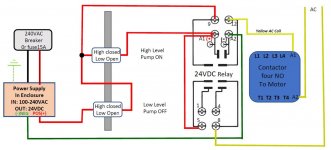Use a 24VDC DPDT relay use one side NO for the latch which is run off of 24VDC inclusive of the coil. The other pole NO to switch one side of the 240VAC going to the contactor or if you want you can get a 3 pole and switch both sides of the 240VAC to A1 and A2. Probably not the best thing to have 240VAC running to float switches in liquid. It is usually recommended to use a spike protection diode on the relay coil due to the reverse voltage spike generated when the coil opens. They sell a small plug in diode if you do not have any diodes laying around.
782-2C-SKT DIN Rail Socket DIN socket for 2P relay
https://www.automationdirect.com/ad...kets_-a-_accessories/relay_sockets/782-2c-skt
782-2C-24D ice cube control relay, socket mount, encapsulated push-to-test, 24 VDC coil voltage, DPDT, 15A contact rating, 8-pin, LED indicator(s)
https://www.automationdirect.com/ad...81_-z-_782_-z-_783_-z-_784_series)/782-2c-24d
Spike protection diode module, package of 5. For use with 782 series relays.
https://www.automationdirect.com/ad...-a-_accessories/relay_accessories/ad-bsmd-250
Power supply 24VDC (0.42A) to run the relay (these usually take around 0.07A)
RHINO PSL series switching power supply, 24 VDC output, 0.42A, 10W, 120/240 VAC or 125-375 VDC nominal input, 1-phase, enclosed, plastic housing, 35mm DIN rail mount, screw terminals, NEC Class 2.
https://www.automationdirect.com/ad...din_rail)/psl_series_(low_profile)/psl-24-010
DIN rail, slotted, 35mm, 7mm height, 4.9in length, plated steel. Package of 2
https://www.automationdirect.com/ad...sure_parts_-a-_accessories/din_rails/din6-p10








